Want to voice-enable your home? Connect smart speakers like Echo or HomePod to your existing appliances using Wi-Fi or Bluetooth. Add smart plugs to older electronics for instant voice control capabilities. Integrate voice recognition with your entertainment system for hands-free media management. Create custom voice commands using Arduino boards for non-smart devices. Implement voice-activated security controls for convenient home protection. These five approaches will transform how you interact with your living space.
Connecting Smart Speakers to Your Existing Home Appliances

While setting up a voice-controlled home might seem challenging, today’s smart speakers make it surprisingly straightforward to breathe new life into your existing appliances.
Most smart speakers support multiple connection protocols like WiFi, Bluetooth, and Zigbee, allowing them to communicate with a wide range of devices you already own.
The growing adoption of the Matter standard means better cross-brand compatibility.
Amazon’s Echo (4th Gen) doubles as a Zigbee hub, while Apple HomePod works within the Home app ecosystem.
For broader compatibility, integrate your smart speaker with existing hubs like SmartThings.
Sonos speakers can play messages and notifications through SmartThings with native integration via an edge driver for better functionality.
Choose speakers supporting multiple protocols to future-proof your setup.
With over 50% of U.S. households now using voice assistants, you’ll join millions who control lights, entertainment systems, and appliances with simple voice commands.
Adding Voice Control to Legacy Electronics With Smart Plugs
Smart plugs represent the easiest gateway to voice-controlled homes, especially for older electronics that lack built-in connectivity.
These affordable devices—often under $10—transform standard outlets into smart ones, letting you control virtually any appliance with voice commands through Alexa or Google Assistant.
You don’t need technical expertise to set up these powerful adapters. Simply plug them in, connect to your 2.4GHz WiFi, and download the manufacturer’s app to start controlling devices remotely. When shopping for a smart plug, be sure to check compatibility limitations to ensure it works with your preferred voice assistant platform.
- Create schedules to automate lamps, coffee makers, or fans to turn on/off at specific times
- Use dual-outlet models for independent control of multiple devices from a single outlet
- Monitor power consumption in real-time with advanced models to track energy usage
Integrating Voice Recognition Into Your Home Entertainment System
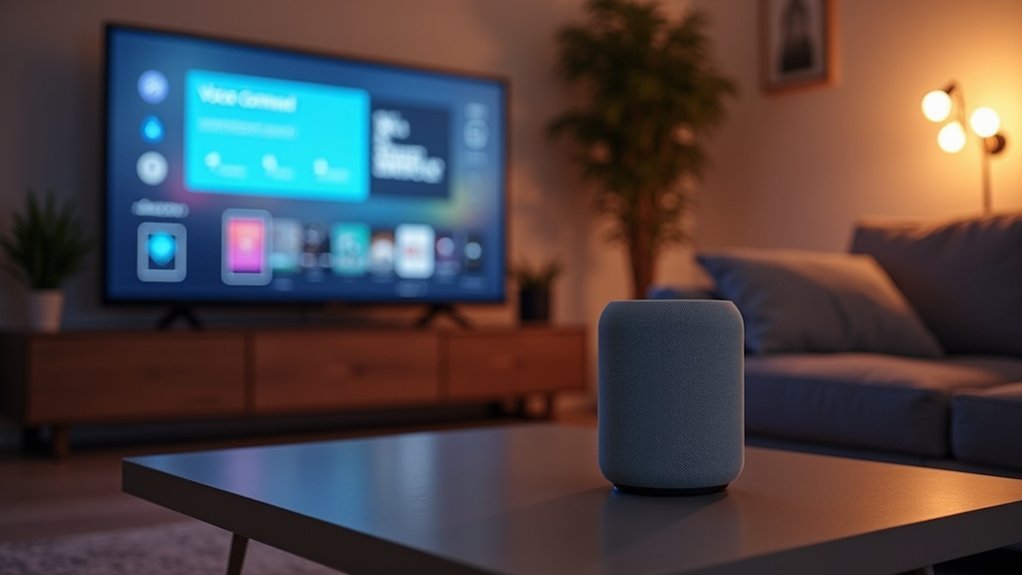
The modern home entertainment system has evolved far beyond simple remote controls into a voice-activated command center. You can connect your TV, soundbar, and streaming devices to platforms like Amazon Alexa, Google Assistant, or Apple’s Siri for seamless control.
Most new entertainment components connect via Wi-Fi or Bluetooth to your voice assistant hub. Once connected, you’ll control everything from powering devices on/off to selecting specific shows with simple commands. This shift represents a larger trend as voice control is increasingly preferred over traditional interfaces such as keypads and remote controls.
Take your setup further by creating custom routines—say “Movie Night” to dim lights, power on your TV, and launch Netflix. You can even integrate these controls with broader home automation scenes for a fully responsive environment.
Remember to review security settings when connecting entertainment devices to maintain privacy while enjoying the convenience.
Creating Custom Voice Commands for Non-Smart Devices
Not every home device comes with built-in voice capabilities, but that doesn’t mean you can’t create your own voice-controlled system for older or non-smart devices. The affordable VC02 module offers offline voice recognition without internet connectivity—perfect for controlling lights, fans, or other appliances through relay switches.
For DIY enthusiasts, Arduino boards paired with voice recognition libraries provide a flexible foundation for custom commands:
- Use custom firmware development to expand functionality and integrate multiple devices through detailed online tutorials.
- Create compact solutions with custom PCBs for cleaner installation and better reliability.
- Maintain privacy and security by keeping all voice processing local—no cloud services required.
The VC02 kit includes dedicated GPIO pins that allow for extensive connections to various electronic components and sensors for comprehensive automation projects.
Remember that each user will need to train the system with their voice, but the privacy benefits often outweigh this minor inconvenience.
Enhancing Home Security With Voice-Activated Controls
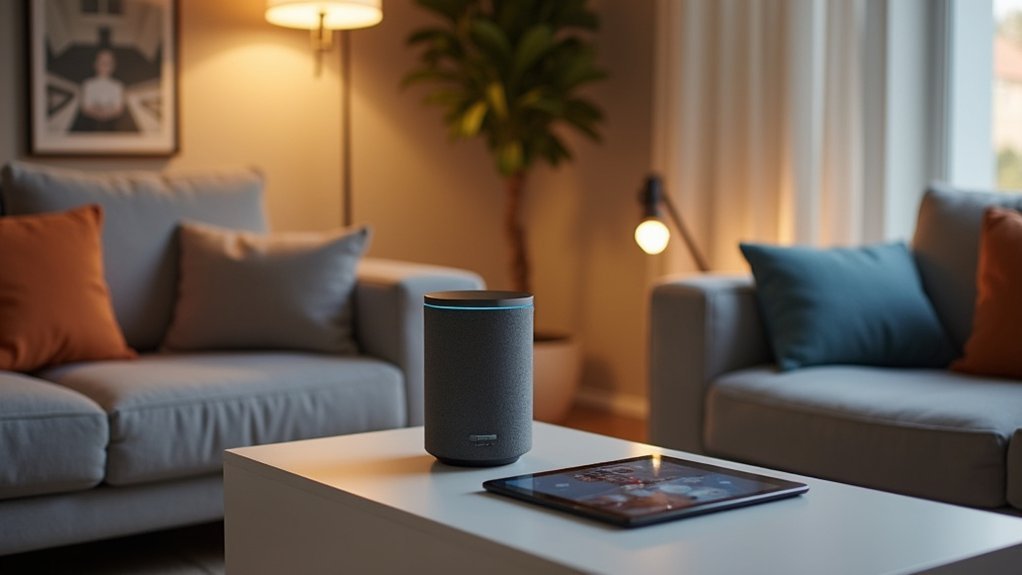
Modern home security has evolved dramatically with voice-activated technology, creating a powerful shield you can control with simple spoken commands.
With over 39 million U.S. households already using alarm systems and 45 million using video doorbells, voice integration offers a natural extension to existing security setups.
You’ll gain hands-free ability to arm systems, check camera feeds, and receive instant alerts—crucial benefits during emergencies or when your hands are full.
For elderly or disabled users, voice commands provide essential independence in managing home safety.
Beyond convenience, voice activation enables extensive security routines where a single command can lock doors, activate exterior lights, and arm alarms simultaneously.
As this technology continues growing at 14.2% annually, you’re looking at smarter, more responsive protection for your home.
A growing number of Americans are incorporating these security features with in-home voice assistants to create comprehensive home protection systems.
Frequently Asked Questions
How Can I Prevent Unauthorized Users From Accessing My Voice-Controlled Devices?
You’ll prevent unauthorized access by using complex passwords, enabling two-factor authentication, muting devices when not in use, restricting guest access, and regularly updating firmware. Always review activity logs for suspicious commands.
Can Voice Assistants Work Effectively Without High-Speed Internet Connections?
Yes, you can use voice assistants without high-speed internet. Offline assistants process commands locally on your device, offering basic functionality with less latency, though you’ll miss advanced features that require cloud connections.
Will Voice-Enabled Devices Increase My Monthly Electricity Bill Significantly?
No, your voice-enabled devices won’t markedly increase your electricity bill. They consume minimal power (1-15 watts), and their automation features often create energy savings that offset or exceed their modest consumption costs.
How Do I Resolve Compatibility Issues Between Different Smart Home Platforms?
To resolve compatibility issues between smart home platforms, you’ll need to use unified hubs, research before purchasing, consider Matter-compatible devices, reset devices when needed, and explore third-party integration tools like IFTTT or Home Assistant.
Are There Voice Control Solutions for People With Speech Impediments?
Yes, you’ll find specialized options like Voiceitt that adapt to your unique speech patterns. Mainstream assistants now offer improved accessibility features, and electronic fluency devices can help enhance your speech clarity when using voice controls.
In Summary
Voice-enabling your home doesn’t mean replacing everything you own. You’ve now got multiple ways to bring smart functionality to both new and older devices. Whether you’re connecting speakers, using smart plugs, integrating entertainment systems, creating custom commands, or enhancing security, you’re building a more convenient and accessible home. Start with one area and you’ll quickly discover how voice control transforms your daily routines.

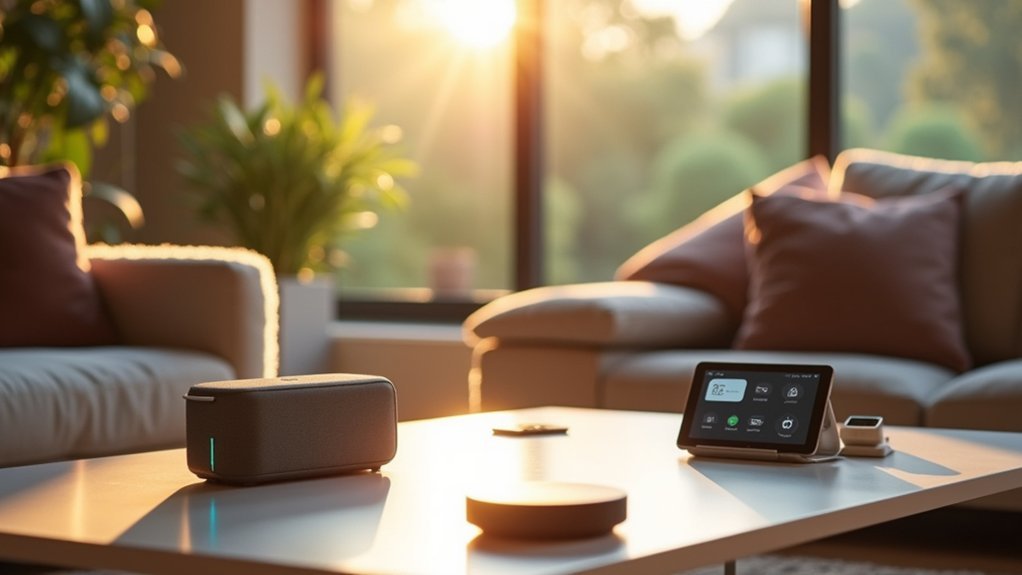
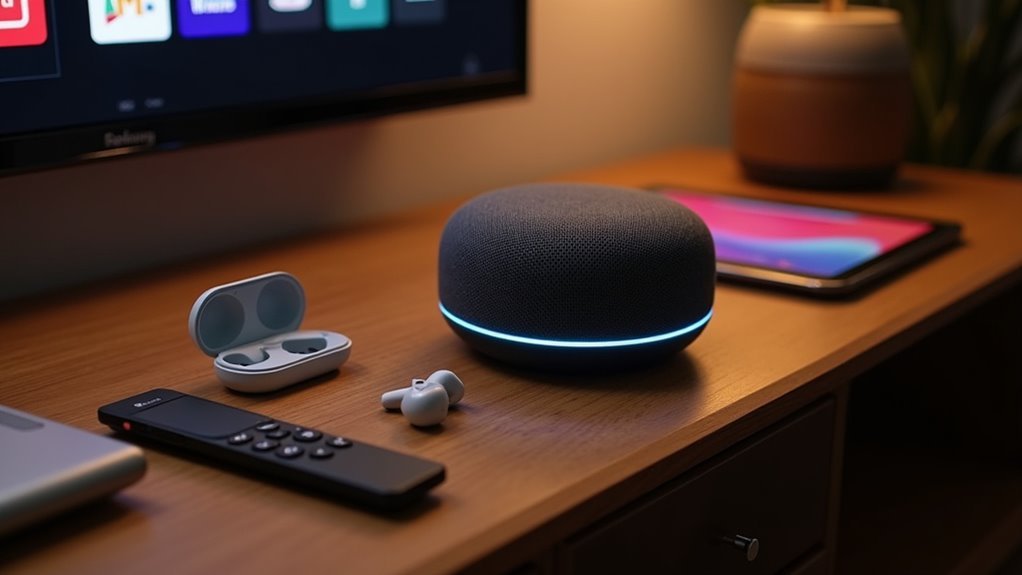
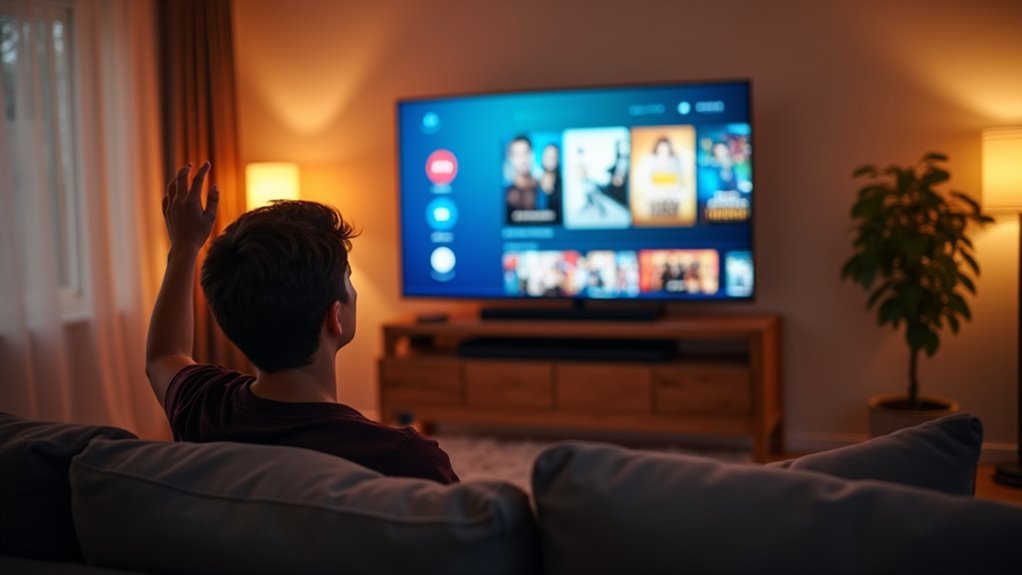

Leave a Reply